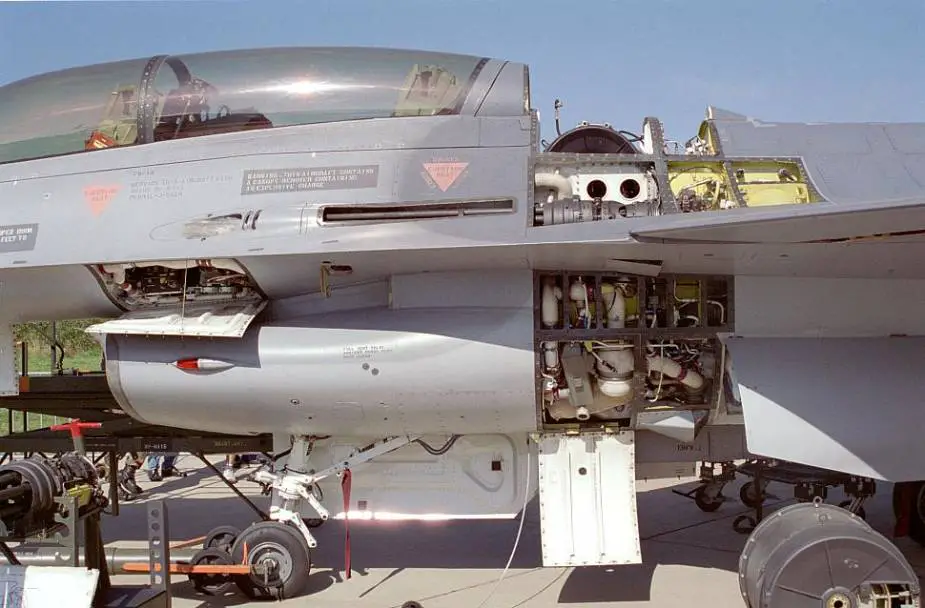Breaking news
General Dynamics-OTS to supply M61A1 Vulcan 20mm guns for F-16s through FMS.
General Dynamics-OTS has been awarded an $88,275,000 firm-fixed-price, indefinite-delivery/indefinite-quantity requirements contract for the purchase of M61A1 Vulcan 20mm cannon guns. This contract provides for the production of the guns in support of the F-16 weapon system. Work will be performed in Williston, Vermont, and is expected to be completed by Dec. 12, 2031. This award is the result of a sole-source acquisition. Foreign Military Sales funds in the amount of $7,853,702 will be obligated on the first order at the time of the award. Air Force Life Cycle Management Center, Robins Air Force Base, Georgia, is the contracting activity.
Follow Air Recognition on Google News at this link

M61A1 Vulcan gun in a Belgian Air Force F-16B at the 1993 airshow at Florennes AB. (Picture source: F-16.net)
The M61 Vulcan is a hydraulically, electrically or pneumatically driven, six-barrel, air-cooled, electrically fired Gatling-style rotary cannon that fires 20mm (0.787 in.) rounds at an extremely high rate (typically 6,000 rounds per minute). The M61 and its derivatives have been the principal cannon armament of United States military fixed-wing aircraft for sixty years.
The M61 was originally produced by General Electric. After several mergers and acquisitions, it is currently produced by General Dynamics. The development of the Lockheed F-104 Starfighter revealed that the T171 Vulcan (later redesignated M61) suffered problems with its linked ammunition, being prone to misfeed and presenting a foreign object damage hazard with discarded links. A linkless ammunition feed system was developed for the upgraded M61A1, which subsequently became the standard cannon armament of U.S. fighters.
In 1993, General Electric sold its aerospace division, including GE Armament Systems along with the design and production tooling for the M61 and GE's other rotary cannon, to Martin Marietta. After Martin's merger with Lockheed, the rotary cannon became the responsibility of Lockheed Martin Armament Systems. Lockheed Martin Armament Systems was later acquired by General Dynamics, which currently produces the M61 and its variants.
The self-powered version, the GAU-4 (called M130 in Army service), is gas-operated, tapping gun gas from three of the six barrels to operate the gun gas-driven mechanism. The self-powered Vulcan weighs about 4.5 kilograms (10 lb) more than its electric counterpart, but requires no external power source to operate, except for an electric, inertia starter to initiate gun rotation, allowing the first rounds to be chambered and fired.
The initial M61 used linked ammunition, but the ejection of spent links created considerable (and ultimately insuperable) problems. The original weapon was soon replaced by the M61A1, with a linkless feed system. Depending on the application, the feed system can be either single-ended (ejecting spent cases and unfired rounds) or double-ended (returning casings back to the magazine). A disadvantage of the M61 is that the bulk of the weapon, its feed system, and ammunition drum make it difficult to fit it into a densely packed airframe.
The feed system must be custom-designed for each application, adding 140 to 180 kg (300 to 400 lb) to the complete weapon. Most aircraft installations are double-ended, because the ejection of empty cartridges can cause a foreign-object damage hazard for jet engines and because the retention of spent cases assists in maintaining the center of gravity of the aircraft. The first aircraft to carry the M61A1 was the C model of the F-104, starting in 1959.
A lighter version of the Vulcan developed for use on the F-22 Raptor, designated M61A2, is mechanically the same as the M61A1, but with thinner barrels to reduce overall weight to 92 kilograms (202 lb). The rotor and housing have also been modified to remove any piece of metal not absolutely needed for operation and replace some metal components with lighter-weight materials. The F/A-18E/F Super Hornet also uses this version.
The Vulcan's rate of fire is typically 6,000 rounds per minute, although some versions (such as that of the AMX and the F-106 Delta Dart) are limited to a lower rate, and others (A-7 Corsair) have a selectable rate of fire of either 4,000 or 6,000 rounds per minute. The M61A2's lighter barrels allow a somewhat higher rate of fire, up to 6,600 rounds per minute.


























